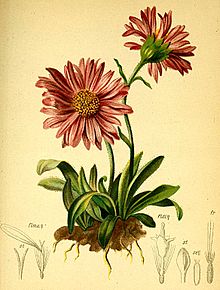Alpine aster
| Alpine aster | ||||||||||||
|---|---|---|---|---|---|---|---|---|---|---|---|---|

Alpine aster ( Aster alpinus ) |
||||||||||||
| Systematics | ||||||||||||
|
||||||||||||
| Scientific name | ||||||||||||
| Aster alpinus | ||||||||||||
| L. |
The alpine aster ( Aster alpinus ), also Alpine star flower , Blue Gamsblüh , Blue Gamswurz or Blue Mountain Star herb called, is a species of the genus aster ( Aster ) in the family of the daisy family (Asteraceae).
description
Vegetative characteristics
The alpine aster is a perennial, herbaceous plant that reaches heights of 5 to 20 centimeters. The stem and the elongated leaves are downy hairy. The basal leaves are petiolate, the stem leaves are sessile.
Generative characteristics
There is only one large, cup-shaped inflorescence per stem, 3 to 5 centimeters in diameter. The large flower head contains a number of purple ray-flowers and many golden-yellow tubular flowers (disc flowers). The envelope scales are lanceolate and sit in several rows on the flower head. The flowering period extends from July to September.
The fruits ( achenes ) are 3 to 4 millimeters long, hairy protruding and with a rough pappus .
The number of chromosomes is 2n = 18 or 36.
Occurrence and protection
The alpine aster thrives best on dry, warm and calcareous soils . It occurs from the valley up to altitudes of 3100 meters. It is often found together with the edelweiss . It occurs mainly in plant communities of the associations Seslerion and Elynion and is a national character species of the class Carici rupestris-Kobresietea bellardii. In the Allgäu Alps, it rises in the Tyrolean part of 1150 meters between Eibelealpe and Unterer Lichtalpe up to an altitude of 2300 meters on the Hochgehren west of the Biberkopf .
In the Harz, the Alpine aster is considered an ice age relic and occurs there in the company of the Astero-Festucetum pallentis.
The Alpine Aster is protected in Germany under the Federal Species Protection Ordinance.
Systematics and distribution
Aster alpinus was first published by Carl von Linné .
The alpine aster is widespread in Europe from the Pyrenees , Alps , Tatras to the Balkans and in Asia and North America .
There are some subspecies or varieties, depending on the author:
- Aster alpinus L. subsp. alpinus (Syn .: Aster garibaldii Brügger , Aster hispanicus Coincy , Aster korshinskyi Tamamsch. , Aster alpinus subsp. dolomiticus (Beck) Hayek , Aster alpinus var. dolomiticus Beck ): It is widespread in Eurasia .
- Aster alpinus subsp. bohemicus (Rchb.) Dostál : It occurs in the Czech Republic .
- Aster alpinus subsp. breyninus (Beck) Hayek : It occurs in Austria and Slovakia .
- Aster alpinus subsp. cebennensis (Braun-Blanq.) Braun-Blanq. : It occurs in France .
- Aster alpinus subsp. cylleneus (Boiss. & Orph.) Hayek (Syn .: Aster cylleneus (Boiss. & Orph.) Halácsy , Aster alpinus var. cylleneus Boiss. & Orph. ): It occurs in Greece and Macedonia .
- Aster alpinus subsp. glabratus (Herbich) Dostál : It occurs in the Czech Republic and Slovakia .
- Aster alpinus subsp. parviceps Novopokr. : It occurs in Eastern European Russia .
- Aster alpinus subsp. subvillosus (Schur) Dostál : It occurs in the Czech Republic and Slovakia.
- Aster alpinus subsp. tolmatschevii (Tamamsch.) Á.Löve & D.Löve ( Aster tolmatschevii Tamamsch. ): It occurs in northern and eastern European Russia.
- Aster alpinus subsp. vierhapperi Onno (syn .: Aster alpinus var. vierhapperi (Onno) Cronquist , Aster Culminis A.Nelson ): it is in North America in the Canadian provinces of Ontario , Alberta , British Columbia , Northwest Territory and Yukon Territory and in the US states Alaska , Colorado , Idaho , Wyoming, and eastern Asia.
use
Some varieties are used as ornamental plants in parks and gardens.
More pictures
In the Berlin Botanical Garden
On the Raxalpe (Eastern Alps) at 1500 meters above sea level
At the natural site in the Tatra Mountains
literature
- Xaver Finkenzeller, Jürke Grau: Alpine flowers. Recognize and determine (= Steinbach's natural guide ). Mosaik, Munich 2002, ISBN 3-576-11482-3 .
- Manfred A. Fischer, Wolfgang Adler, Karl Oswald: Excursion flora for Austria, Liechtenstein and South Tyrol . 2nd, improved and enlarged edition. State of Upper Austria, Biology Center of the Upper Austrian State Museums, Linz 2005, ISBN 3-85474-140-5 .
Individual evidence
- ↑ a b Aster alpinus L., Alpine Aster. In: FloraWeb.de.
- ↑ a b c Erich Oberdorfer : Plant-sociological excursion flora for Germany and neighboring areas . With the collaboration of Angelika Schwabe and Theo Müller. 8th, heavily revised and expanded edition. Eugen Ulmer, Stuttgart (Hohenheim) 2001, ISBN 3-8001-3131-5 , pp. 911 .
- ↑ Erhard Dörr, Wolfgang Lippert : Flora of the Allgäu and its surroundings. Volume 2, IHW, Eching 2004, ISBN 3-930167-61-1 , p. 570.
- ↑ a b c d e f g h i Werner Greuter (2006+): Compositae (pro parte majore). In: W. Greuter, E. von Raab-Straube (Ed.): Compositae. In: Aster alpinus data sheet In: Euro + Med Plantbase - the information resource for Euro-Mediterranean plant diversity.
- ↑ a b c Aster alpinus in the Germplasm Resources Information Network (GRIN), USDA , ARS , National Genetic Resources Program. National Germplasm Resources Laboratory, Beltsville, Maryland. Retrieved April 17, 2016.
Web links
- Aster alpinus subsp. alpinus L., Alpine aster (subspecies). In: FloraWeb.de.
- Alpine aster . In: BiolFlor, the database of biological-ecological characteristics of the flora of Germany.
- Profile and distribution map for Bavaria . In: Botanical Information Hub of Bavaria .
- Aster alpinus L. In: Info Flora , the national data and information center for Swiss flora . Retrieved April 15, 2016.
- Thomas Meyer: Aster data sheet with identification key and photos at Flora-de: Flora von Deutschland (old name of the website: Flowers in Swabia ).







